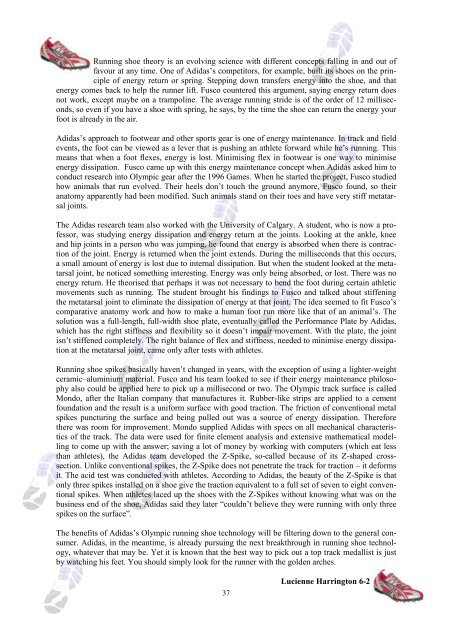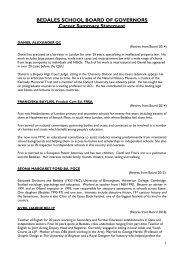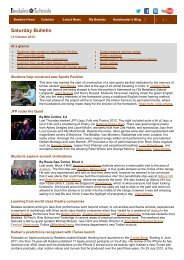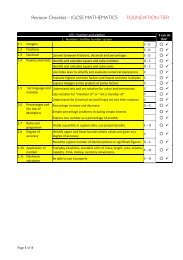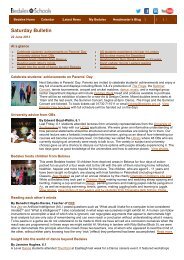You also want an ePaper? Increase the reach of your titles
YUMPU automatically turns print PDFs into web optimized ePapers that Google loves.
Running shoe theory is an evolving science with different concepts falling in and out offavour at any time. One of Adidas’s competitors, for example, built its shoes on the principleof energy return or spring. Stepping down transfers energy into the shoe, and thatenergy comes back to help the runner lift. Fusco countered this argument, saying energy return doesnot work, except maybe on a trampoline. The average running stride is of the order of 12 milliseconds,so even if you have a shoe with spring, he says, by the time the shoe can return the energy yourfoot is already in the air.Adidas’s approach to footwear and other sports gear is one of energy maintenance. In track and fieldevents, the foot can be viewed as a lever that is pushing an athlete forward while he’s running. Thismeans that when a foot flexes, energy is lost. Minimising flex in footwear is one way to minimiseenergy dissipation. Fusco came up with this energy maintenance concept when Adidas asked him toconduct research into Olympic gear after the 1996 Games. When he started the project, Fusco studiedhow animals that run evolved. Their heels don’t touch the ground anymore, Fusco found, so theiranatomy apparently had been modified. Such animals stand on their toes and have very stiff metatarsaljoints.The Adidas research team also worked with the University of Calgary. A student, who is now a professor,was studying energy dissipation and energy return at the joints. Looking at the ankle, kneeand hip joints in a person who was jumping, he found that energy is absorbed when there is contractionof the joint. Energy is returned when the joint extends. During the milliseconds that this occurs,a small amount of energy is lost due to internal dissipation. But when the student looked at the metatarsaljoint, he noticed something interesting. Energy was only being absorbed, or lost. There was noenergy return. He theorised that perhaps it was not necessary to bend the foot during certain athleticmovements such as running. The student brought his findings to Fusco and talked about stiffeningthe metatarsal joint to eliminate the dissipation of energy at that joint. The idea seemed to fit Fusco’scomparative anatomy work and how to make a human foot run more like that of an animal’s. Thesolution was a full-length, full-width shoe plate, eventually called the Performance Plate by Adidas,which has the right stiffness and flexibility so it doesn’t impair movement. With the plate, the jointisn’t stiffened completely. The right balance of flex and stiffness, needed to minimise energy dissipationat the metatarsal joint, came only after tests with athletes.Running shoe spikes basically haven’t changed in years, with the exception of using a lighter-weightceramic–aluminium material. Fusco and his team looked to see if their energy maintenance philosophyalso could be applied here to pick up a millisecond or two. The Olympic track surface is calledMondo, after the Italian company that manufactures it. Rubber-like strips are applied to a cementfoundation and the result is a uniform surface with good traction. The friction of conventional metalspikes puncturing the surface and being pulled out was a source of energy dissipation. Thereforethere was room for improvement. Mondo supplied Adidas with specs on all mechanical characteristicsof the track. The data were used for finite element analysis and extensive mathematical modellingto come up with the answer; saving a lot of money by working with computers (which eat lessthan athletes), the Adidas team developed the Z-Spike, so-called because of its Z-shaped crosssection.Unlike conventional spikes, the Z-Spike does not penetrate the track for traction – it deformsit. The acid test was conducted with athletes. According to Adidas, the beauty of the Z-Spike is thatonly three spikes installed on a shoe give the traction equivalent to a full set of seven to eight conventionalspikes. When athletes laced up the shoes with the Z-Spikes without knowing what was on thebusiness end of the shoe, Adidas said they later “couldn’t believe they were running with only threespikes on the surface”.The benefits of Adidas’s Olympic running shoe technology will be filtering down to the general consumer.Adidas, in the meantime, is already pursuing the next breakthrough in running shoe technology,whatever that may be. Yet it is known that the best way to pick out a top track medallist is justby watching his feet. You should simply look for the runner with the golden arches.37Lucienne Harrington 6-2


